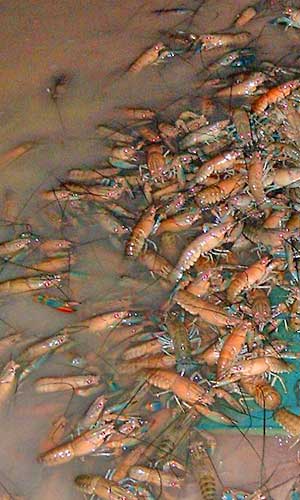 Historically, redclaw crayfish farmers have fed their animals anything that was locally available and cheap to buy and transport. This varied from reject potatoes and grain to chook and dog pellets to “redclaw crayfish” pellets from the closest feed mill. In fact the results from some so called research projects indicated that feed choice mattered little as far as growth was concerned. Feeding intervals varied between every second day and whenever you had time.
Historically, redclaw crayfish farmers have fed their animals anything that was locally available and cheap to buy and transport. This varied from reject potatoes and grain to chook and dog pellets to “redclaw crayfish” pellets from the closest feed mill. In fact the results from some so called research projects indicated that feed choice mattered little as far as growth was concerned. Feeding intervals varied between every second day and whenever you had time.
Feed companies have played a major role in feed development for other primary industry sectors, but approaches from the redclaw crayfish industry met with little interest because of the present relatively small and scattered demand. The industry employed the services of a professional intuitionalist in an attempt at a quick fix, but his suggestions were a result of a very shallow investigation.
The current Selective Breeding Program has proved that it is genetically possible to breed faster growing redclaw crayfish. It is easy to come to the conclusion that this advance cannot be capitalized upon without the best feed and feeding system possible.
May 2015 update: The Feeding and Nutrition research project is nearing completion. By the end of 2015 the resulting feed will be available from nominated SQ and NQ feed mills that will be making the feed under license to QCFA and will be clearly branded with the QCFA logo.
More information will become available following completion of the current performance trails.
Testing redclaw pellets
James Cook University, on behalf of the Redclaw crayfish industry and with its financial support and enthusiastic backing, is half way through a five year feeding and nutrition study, again funded by the RIRDC. (View project details)
Startling results have already been accomplished in the areas of pellet size and stability and also optimum feeding intervals. As the results of this work are obtained we will update the information here. This work has the potential to bring big increases to the productivity of Redclaw crayfish farming, save unnecessary costs, and reduce work load.


